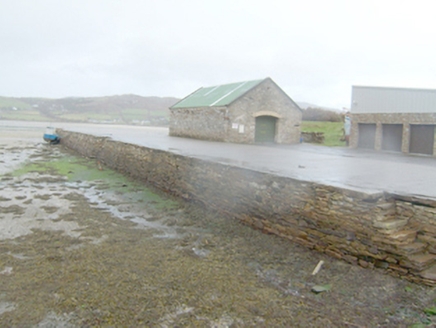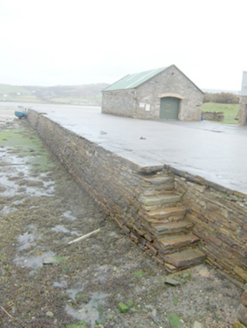Survey Data
Reg No
40807022
Rating
Regional
Categories of Special Interest
Architectural, Social, Technical
Original Use
Pier/jetty
In Use As
Pier/jetty
Date
1825 - 1835
Coordinates
201834, 437437
Date Recorded
18/11/2010
Date Updated
--/--/--
Description
Pier\jetty, erected c. 1831. Constructed of coursed squared sandstone masonry with squared rubble sandstone coping to the west edge. Three flights of cut sandstone steps to the west side. Tarmacadam deck. Slipway to the north-east. Single-bay single-storey boathouse to pier having pitched corrugated-metal roof with raised rendered verges to the gable ends, rubble stone walls, and segmental-headed carriage-arch to the south elevation having red voussoirs, and with modern door. Two cast-iron lamps to south and slipway to north. Juts out into Sheephaven Bay a short distance to the north of the centre of Dunfanaghy.
Appraisal
This stone built pier is a reminder of the engineering achievements in the early-nineteenth century that enabled the economic and social development of the local community. Its survival and continued use is a testament to the high quality of its original design and construction. It acts as a tangible reminder of the maritime activities that traditionally supported the local economy. The pier is also of technical significance, and was built using local sandstone masonry by local labour. The flights of cut stone steps and the cut stone coping to the west verge add some additional interest. It is depicted on the Ordnance Survey first edition six-inch map of c. 1834, but part of the harbour was later infilled to the south to create the area around the former market house (see 40807006). The First Report of the Commissioners of Inquiry into The State of the Irish Fisheries (1836?) records ‘there is a small quay [at Dunfanaghy], which has the same depth of water as the bar, and the fishermen have great convenience for drying fish and nets. The quay was erected by contributions, sent from England in 1831, during a period of scarcity; the people having been employed to erect it by a committee appointed to distribute the provisions, in which payment was made for their labour. The quay is in pretty good repair, and a toll of one shilling a ton is collected for maintaining it. Its erection has not had any effect on it. The proprietor of the soil is Mr. Stewart, of Ards.’ The boathouse to the centre of the pier is a later addition, c. 1880. This is robustly built using local rubble stone masonry, and adds to the setting and context of the pier, which is an integral element of the built heritage and social history of the local area.







